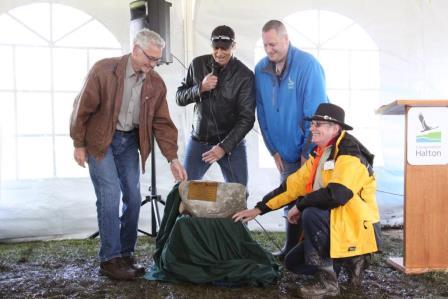
Here’s some tree-planting news from Conservation Halton:
Nearly 300 community volunteers and local Halton Scouts helped to plant 3,000 trees and shrubs at the ninth annual Conservation Halton Trees for Watershed Health Tree Planting this past weekend on Sunday, May 4 at the Halton Waste Management Site.
Conservation Halton partnered with Halton Region and local Halton Scouts for this year’s Trees for Watershed Health planting. Since 2000, more than 2,000 native trees have been planted at the Halton Waste Management Site by Halton-area Scouts, which is an example of the sound environmental practices applied at Site operations.
“Thank you to everyone who took their time out of their weekend to participate in the tree planting. It’s always gratifying to see so many parents who bring their children out and instill the ethic of stewardship,” commented Conservation Halton Chair John Vice. “Conservation Halton is pleased this year to partner with Halton Region and the Scouts, these community partnerships are greatly valued and make us all more effective.”
“Protecting the environment continues to be a top priority for Halton and Region and one that can only be accomplished through partnerships with local organizations and community volunteers,” said Halton Regional Chair, Gary Carr. “I would like to thank Conservation Halton, our local scouts, our community volunteers and the staff at the Halton Waste Management Site for their ongoing commitment to protecting and preserving our natural environment.”
Conservation Halton released a Watershed Report Card in 2013, which reported on the health of the local environment on four different factors. A minimum of 30 per cent forest cover is typically required for overall watershed health. The overall forest cover in our watershed was 26.4 per cent or a grade of C. The majority of large forested areas are located above the Niagara Escarpment.
For more than 50 years, Conservation Halton has played a major role in forest management, tree and shrub planting, and reforestation throughout our watershed. These activities provide a variety of environmental benefits, which include protecting water quality and quantity, reducing soil erosion, and cleaning our air.

About Trees for Watershed Health
The Trees for Watershed Health program is designed to bring the community and nature together to increase forest cover in the watershed through volunteers planting trees at selected sites. In nine years of tree plantings more than 4,700 volunteers have planted in excess of 47,500 trees. The Trees for Watershed Health program was launched in 2006 with the assistance of funding from the Ontario Trillium Foundation. For more information visit our website, http://www.conservationhalton.ca/trees-for-watershed-health www.conservationhalton.ca/trees-for-watershed-health




